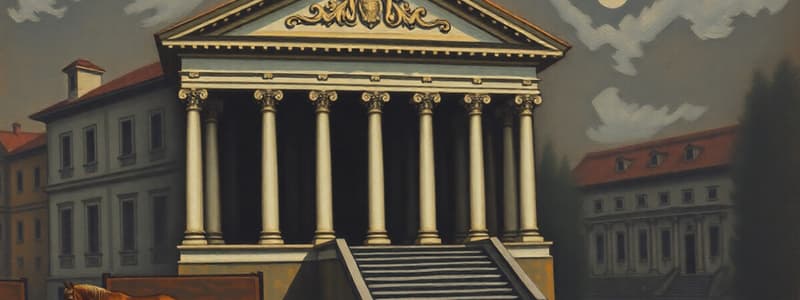Podcast
Questions and Answers
Which of the following is NOT a limitation of a barter system?
Which of the following is NOT a limitation of a barter system?
- Ability to store wealth easily (correct)
- Lack of store of value
- Difficulty in finding matching needs
- Lack of standard for deferred payment
Fiat money is backed by a physical commodity.
Fiat money is backed by a physical commodity.
False (B)
What is the definition of money?
What is the definition of money?
Anything which is generally acceptable as a medium of exchange.
Money supply is calculated using the formula ______ = CASA + CR + SA.
Money supply is calculated using the formula ______ = CASA + CR + SA.
Match the following money supply categories with their definitions:
Match the following money supply categories with their definitions:
What role does the central bank play in clearing house transactions between commercial banks?
What role does the central bank play in clearing house transactions between commercial banks?
The central bank does not require commercial banks to maintain a cash reserve ratio.
The central bank does not require commercial banks to maintain a cash reserve ratio.
What happens to the lending rates of commercial banks when the central bank increases the bank rate?
What happens to the lending rates of commercial banks when the central bank increases the bank rate?
The ________ rate is the rate at which the central bank lends money to commercial banks for short-term needs.
The ________ rate is the rate at which the central bank lends money to commercial banks for short-term needs.
Match the following terms with their definitions:
Match the following terms with their definitions:
What action will the central bank take if it wants to decrease the money supply through open market operations?
What action will the central bank take if it wants to decrease the money supply through open market operations?
A decrease in the reverse repo rate encourages commercial banks to deposit more money with the central bank.
A decrease in the reverse repo rate encourages commercial banks to deposit more money with the central bank.
How does an increase in the repo rate affect individual borrowers?
How does an increase in the repo rate affect individual borrowers?
What does CRR stand for?
What does CRR stand for?
Increasing the reserve ratio leads to an increase in the credit creating capacity of commercial banks.
Increasing the reserve ratio leads to an increase in the credit creating capacity of commercial banks.
What is the purpose of margin requirement in lending?
What is the purpose of margin requirement in lending?
In a barter system, goods are exchanged for _____
In a barter system, goods are exchanged for _____
Which issue is NOT a problem of the barter system?
Which issue is NOT a problem of the barter system?
Match the following components with their descriptions:
Match the following components with their descriptions:
Lack of common measure of value is a significant issue in a barter system.
Lack of common measure of value is a significant issue in a barter system.
What does the term 'credit derationing' refer to?
What does the term 'credit derationing' refer to?
What is the primary function of a commercial bank?
What is the primary function of a commercial bank?
A commercial bank can only create credit equal to the amount of initial deposits.
A commercial bank can only create credit equal to the amount of initial deposits.
What does LRR stand for in the context of banking?
What does LRR stand for in the context of banking?
The central bank has the sole authority to issue __________ in a country.
The central bank has the sole authority to issue __________ in a country.
If an initial deposit of Rs 25,000 is made with a LRR of 20%, what will be the total loan amount that can be created?
If an initial deposit of Rs 25,000 is made with a LRR of 20%, what will be the total loan amount that can be created?
The central bank acts as a banker, agent, and advisor to the government.
The central bank acts as a banker, agent, and advisor to the government.
In terms of credit creation, 'K' is calculated as __________.
In terms of credit creation, 'K' is calculated as __________.
Match the following functions of the central bank with their descriptions:
Match the following functions of the central bank with their descriptions:
Flashcards
Clearing House
Clearing House
A service where transactions between banks are settled by the central bank through a single entry.
Custodian of Cash Reserve Ratio
Custodian of Cash Reserve Ratio
The central bank holds a percentage of commercial banks' net deposits as reserves.
Bank Rate
Bank Rate
The interest rate at which the central bank lends to commercial banks for long-term borrowings.
Repo Rate
Repo Rate
Signup and view all the flashcards
Reverse Repo Rate
Reverse Repo Rate
Signup and view all the flashcards
Open Market Operation
Open Market Operation
Signup and view all the flashcards
Quantitative Monetary Policy
Quantitative Monetary Policy
Signup and view all the flashcards
Qualitative Monetary Policy
Qualitative Monetary Policy
Signup and view all the flashcards
Legal Reserve Ratio
Legal Reserve Ratio
Signup and view all the flashcards
CRR
CRR
Signup and view all the flashcards
SLR
SLR
Signup and view all the flashcards
Margin Requirement
Margin Requirement
Signup and view all the flashcards
Moral Suasion
Moral Suasion
Signup and view all the flashcards
Selective Credit Control
Selective Credit Control
Signup and view all the flashcards
Barter System
Barter System
Signup and view all the flashcards
Double Coincidence of Wants
Double Coincidence of Wants
Signup and view all the flashcards
Store of Value
Store of Value
Signup and view all the flashcards
Deferred Payment
Deferred Payment
Signup and view all the flashcards
Fiat Money
Fiat Money
Signup and view all the flashcards
Money Supply
Money Supply
Signup and view all the flashcards
Commercial Bank
Commercial Bank
Signup and view all the flashcards
Credit Creation
Credit Creation
Signup and view all the flashcards
LRR (Legal Reserve Ratio)
LRR (Legal Reserve Ratio)
Signup and view all the flashcards
K (Credit Multiplier)
K (Credit Multiplier)
Signup and view all the flashcards
Function of Central Bank
Function of Central Bank
Signup and view all the flashcards
Bank of Note Issue
Bank of Note Issue
Signup and view all the flashcards
Custodian of Foreign Exchange Reserve
Custodian of Foreign Exchange Reserve
Signup and view all the flashcards
Lender of Last Resort
Lender of Last Resort
Signup and view all the flashcards
Study Notes
Money and Banking
- Commercial banks are financial institutions that accept deposits, grant loans, and make investments to earn profits.
- Credit creation is a process where commercial banks generate more deposits than their initial deposits.
- Assumptions include considering all banking as a single unit and all transactions processed through banks.
Initial Deposit and LRR Calculation
- An example scenario: A depositor initially deposits ₹5000.
- The bank deducts 20%, i.e., ₹1000 (LRR).
- This leaves ₹4000 for loans.
- This loan amount can be further lent, creating additional deposits
Central Bank Functions
- The central bank controls, operates, and regulates the entire banking system of a country.
- It issues currency (except one rupee notes and coins, which are issued by the Ministry of Finance).
- It manages and controls the money supply in the country.
- It maintains the external value of currency.
- It ensures uniformity in note issuance.
- It acts as a banker and advisor to the government, receiving and managing government funds.
- It acts as a custodian of foreign exchange reserves.
Banking Functions for Commercial Banks
- Lender of last resort: Banks can approach the central bank to meet financial obligations when needed
- Clearing house: facilitates transactions between banks.
Cash Reserve Ratio
- Every commercial bank is required to maintain a certain percentage of its net deposits with the central bank (RBI).
- The central bank acts as the custodian of this cash reserve ratio.
Monetary Policy
- Bank Rate:
- The rate at which a central bank lends to commercial banks for long-term borrowing.
- Increasing the bank rate decreases money supply, discourages borrowers.
- Decreasing the bank rate increases money supply, encourages borrowers.
- Repo Rate:
- The rate at which central banks lend money to commercial banks for short-term borrowings.
- Increasing the repo rate decreases money supply, discourages borrowers.
- Decreasing the repo rate increases money supply, encourages borrowers.
- Reverse Repo Rate:
- The rate at which central banks borrow money from commercial banks.
- Raising this rate reduces the money supply.
- Lowering this rate increases the money supply.
- Open Market Operations (OMO):
- Buying and selling government securities.
- Buying securities increases the money supply.
- Selling securities decreases the money supply.
Legal Reserve Ratio (LRR/CRR)
- A component of LRR is the Cash Reserve Ratio (CRR)
- A percentage of deposits that commercial banks must maintain with the central bank.
- The central bank uses CRR to control the money supply.
- The other component is the Statutory Liquidity Ratio (SLR)
Qualitative Measures
- Marginal Requirements: The difference between the amount of loan granted by a bank to the value of securities offered. A higher margin decreases loan availability and reduces money supply. Lowering the margin stimulates lending and increases money supply
- Moral Suasion: The central bank persuades commercial banks to follow a specific policy through orders and suggestions
- Selective Credit Control: Manipulating the types of loans banks can give to manage the money supply. Credit rationing regulates loan availability either to boost or to reduce the economy.
Barter System Notes
- A system of exchanging goods for goods.
- Issues of the barter system include a lack of a universal measure of value and the need for a "double coincidence of wants," where both parties have what the other wants for an exchange.
Money Definitions
- Money is anything acceptable as exchange medium, with a store of value, measure of value and a standard for deferred payments.
- Money Supply is the overall volume of money in an economy at a specific point.
- Different measures of money supply exist accounting for different types of deposits (M1, M2, M3).
Studying That Suits You
Use AI to generate personalized quizzes and flashcards to suit your learning preferences.




